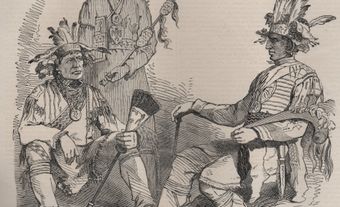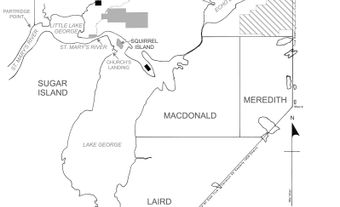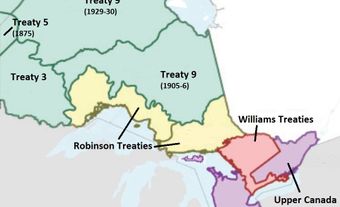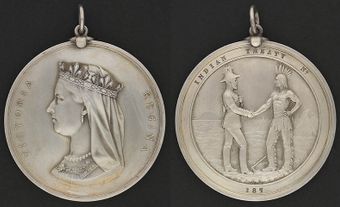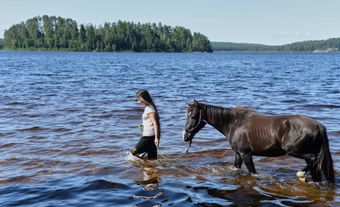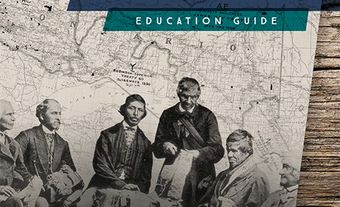The Sombra Township Treaty of 1796 (also known as Treaty 7 in the Upper Canada treaties numbering system) was an early land agreement between First Nations and British authorities in Upper Canada (later Ontario). It was one of a series of Upper Canada Land Surrenders. The Sombra Township Treaty encompassed a tract of land 12 miles square (about 31 kilometres square) on the St. Clair River in the southwestern part of the colony. The British originally purchased it to offer it for settlement to their Indigenous allies who had fought with them during the American Revolution but who still lived in the new nation of the United States."

Historical Context
After the American Revolution (1775–83), many Indigenous allies of the British during that war continued to live in what was now American territory south and west of the Great Lakes. They continued to hope that a buffer territory would be created between British and American lands, which would be occupied by Indigenous peoples. This dream did not materialize, and the Americans were anxious to settle Indigenous lands in the Northwest Territory, as the region northwest of the Ohio River was called.
Although British assistance was hoped for, it never came. Despite the lack of British military support, initially the Indigenous peoples in the area were successful in battles against American military expeditions in 1790 and 1791, led by Brigadier General Josiah Harmar and Major General Arthur St. Clair respectively. In response, President George Washington appointed Major General Anthony Wayne commander of a new American professional army: the Legion of the United States.
In 1794, Wayne led an expedition against the Northwest Confederacy, a coalition of warriors led by Miami, Shawnee and Lenape (Delaware) chiefs. The British colonial government ordered their military in the area not to interfere in the battle between the Americans and the Confederacy. This was because the Detroit River now formed the new international border under the terms of the Treaty of Paris signed in 1783. On 20 August, the two sides met at the Maumee River, near modern Toledo, Ohio. At the Battle of Fallen Timbers the Americans decisively defeated the Indigenous warriors. By the Treaty of Greenville, signed in August 1795, the Indigenous peoples ceded much of present-day Ohio, as well as parts of Indiana, Illinois and Michigan to the United States.
After Fallen Timbers, the British offered the Indigenous peoples in the region a haven in Upper Canada, across the new international border of the Detroit River, which was confirmed by Jay’s Treaty, ratified in 1795. McKee’s Purchase of 1790 had acquired most of the land in the intended area and, by 1796, most of it had been occupied by white settlers. A new purchase was necessary to provide land for the Indigenous peoples who had remained loyal to Britain. The area around the Chenail Ecarté (English: wide channel), a tributary of the St. Clair River, was suggested as suitable for this purpose. The southerly flowing St. Clair River connects Lake Huron and Lake St. Clair.
Negotiations
Accordingly, Governor-in-Chief Lord Dorchester sent Deputy Indian Agent Colonel Alexander McKee to complete the necessary arrangements with the Ojibwe of the Chenail Ecarté. McKee had been born around 1735 in what is now Pennsylvania to a Shawnee mother. He was raised in the remote wilderness in the ways of his mother’s people. McKee was a fur trader and Indian agent in the Ohio River area. During the American Revolution, he supported the British and moved to Detroit after the war. He supported Britain’s Indigenous allies as they continued their ultimately unsuccessful battle against American encroachments into their lands. McKee was well-known and respected by the Indigenous peoples of the region. He was instrumental in arranging the terms of Treaty 116 in 1786, as well as McKee’s Purchase in 1790.
McKee estimated that some 2,000 to 3,000 Indigenous allies might accept an offer of land. This included the Odawa of the Raisin River and the Potawatomi of Swan Creek, as well as the Shawnee and Odawa of the Miami River. This was good news to the British, as it meant they would have a large body of loyal warriors living in British territory.
McKee reported to Dorchester that he had reached a provisional agreement with the Ojibwe for the surrender of a tract of land, some 31 kilometres square on the east side of the St. Clair River, north of Lake St. Clair. He was told to proceed with a formal treaty.
On 30 August 1796, McKee met in council with Ojibwe representatives at Chenail Ecarté. McKee noted that the King only wanted four square leagues or about 123 square kilometers “for the use of his Indian children and you yourselves will be as welcome as any others to come and live thereon.” The Ojibwe agreed and the treaty was signed on 7 September. It may be that the chiefs were agreeable because, although they claimed the land in question, few of their people lived there. It could also be that they hoped for British support in expectation of an American invasion of their lands.
For signing the treaty, the Ojibwe received merchandise worth 800 pounds. Included were 882 blankets; hundreds of metres of various kinds of cloth, along with thread and ribbon; 48 pairs of scissors; 24 handkerchiefs; 44 hats; 80 ivory combs and 100 horn ones; 156 mirrors; 36 trunks; 45 hoes; 906 fish hooks and an equal number of flints; 2,304 pipes; 330 pounds of tobacco; 100 fire steels; brass, copper and tin kettles; 10 guns for chiefs; seven rifles and 1,400 pounds of shot and ball. As was customary, the Commissary Department furnished a bullock and rum for a celebratory feast.
Outcome
Unfortunately for the British, McKee’s estimate was highly optimistic and the expected influx of Indigenous peoples from the United States never happened. The land ceded under the treaty was surveyed as Shawnee Township, later renamed Sombra Township and opened to white settlement. Today, much of the Township of St. Clair is located on the tract.

 Share on Facebook
Share on Facebook Share on X
Share on X Share by Email
Share by Email Share on Google Classroom
Share on Google Classroom


